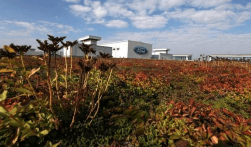Excerpt from the Detroit Free Press:
Ten years after Ford planted vegetation atop a massive truck assembly plant, the largest living roof in the U.S. is flourishing and others have followed the automaker’s lead.
Ford was a pioneer a decade ago when it created a living roof on top of the Dearborn Truck Plant. It was a unique way to save on roofing materials and cooling costs while addressing water runoff and other ecological concerns.
“Ford was incredibly courageous and forward thinking when they evaluated and moved forward with a green roof,” said Clayton Rugh, manager of Xero Flor America in Durham, N.C., whose parent company in Germany worked with Ford on the project. “They became a well-recognized pioneer.”
The success of the Dearborn truck plant roof prompted Ford to do more. A year ago, when a 2,500-square-foot portion of Ford headquarters needed to be redone, the automaker turned a second time to water absorbing plants.
When Ford took the plunge, there were fewer than 50 living roofs in the U.S. Today there are about 10,000 and growing, Rugh said, with numerous companies supplying them. They adorn everything from doghouses and homes to commercial, government and academic buildings. There are 20-30 academic buildings in Michigan alone.
Water-absorbing vegetation now grows on the Empire State building, Nintendo headquarters in Redmond, Wash., a FedEx facility at O’Hare International Airport and a seven-acre spread atop the Javits Center in New York.
Don Russell worked in Ford’s environmental quality office in 2000 when he was given a unique assignment: refine Bill Ford’s vision to reinvigorate the historic Rouge industrial complex by covering the roof with grasses instead of tar or shingles.
“I’m a chemical engineer so it was far from my comfort zone,” Russell remembers. “I was told to evaluate what was out there commercially to do this roof.”
The assignment was more than ecological whimsy. Ford wanted to expand the facility, situated in marshland. There was a cost of about $50 million to meet new water quality regulations by reducing toxic storm water runoff from the plant site into the Rouge River.
Famed eco-architect William McDonough was tapped by Bill Ford to develop the master plan for plant expansion and installing a 10.4-acre meadow on the roof as a natural storm water management system at a cost of only $15 million. Ford spokesman Todd Nissen said studies show the roof has reduced runoff by 42% and contains 85% fewer suspended solids.
More details about the project are available here.
